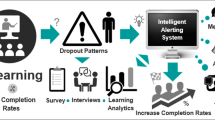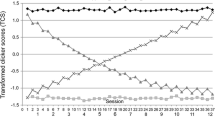Abstract
Higher education institutions are increasingly seeking technological solutions to not only enhance the learning environment but also support students. In this study, we explored the case of an early alert system (EAS) at a regional university engaged in both on-campus and online teaching. Using a total of 16,142 observations captured between 2011 and 2013, we examined the relationship between EAS and the student retention rate. The results indicate that when controlling for demographic, institution, student performance and workload variables, the EAS is able to identify students who have a significantly higher risk of discontinuing from their studies. This implies that early intervention strategies are effective in addressing student retention, and thus an EAS is able to provide actionable information to the student support team.





Similar content being viewed by others
References
Arnold, K. E., & Pistilli, M. D. (2012). Course signals at Purdue: using learning analytics to increase student success. In Proceedings of the Second International Conference on Learning Analytics and Knowledge. ACM. 267-270.
Baker, R. S., D'Mello, S. K., Rodrigo, M. M. T., & Graesser, A. C. (2010). Better to be frustrated than bored: the incidence, persistence, and impact of learners’ cognitive–affective states during interactions with three different computer-based learning environments. International Journal of Human-Computer Studies., 68(4), 223–241.
Baker, R. S., Lindrum, D., Lindrum, M. J., and Perkowski, D. (2015). Analyzing early at-risk factors in higher education e-learning courses. Retrieved 12/09/2015 from http://www.columbia.edu/~rsb2162/2015paper41.pdf
Caufield, M. (2013a). A simple, less mathematical wat to understand the course signals issue. Hapgood. Retrieved 10/07/2015, from http://hapgood.us/2013/09/26/a-simple-less-mathematical-way-to-understand-the-course-signals-issue/
Caufield, M. (2013b). Why the course signals math does not add up. Hapgood. Retrieved 08/12/2014 from http://hapgood.us/2013/09/26/why-the-course-signals-math-does-not-add-up/
Cox, D. R. (1972). Regression models and life-tables. Journal of the Royal Statistical Society. Series B (Methodological), 187–220.
DesJardins, S. L. (2003). Event history methods: conceptual issues and an application to student departure from college. Higher Education: Handbook of Theory and Research, Springer. 421–471.
DesJardins, S. L., Ahlburg, D. A., & McCall, B. P. (1999). An event history model of student departure. Economics of Education Review, 18(3), 375–390.
DesJardins, S. L., Ahlburg, D. A., & McCall, B. P. (2002). A temporal investigation of factors related to timely degree completion. The Journal of Higher Education, 73(5), 555–581 Retrieved from http://www.jstor.org/stable/1558433.
Ferguson, R., Clow, D., Macfadyen, L., Tynan, B., Dawson, S., & Alexander, S. (2015). Setting learning analytics in context: overcoming the barriers to large-scale adoption. Journal of Learning Analytics, 1(3), 120–144.
Harrison, S., Villano, R., Lynch, G., & Chen, G. (2016). Measuring financial implications of an early alert system. In Proceedings of the Sixth International Conference on Learning Analytics & Knowledge (pp. 241-248). ACM.
Ishitani, T. T. (2006). Studying attrition and degree completion behavior among first-generation college students in the United States. The Journal of Higher Education, 77(5), 861–885 Retrieved from http://www.jstor.org/stable/3838790.
Ishitani, T. T., & DesJardins, S. L. (2003). A longtitudinal investigation of dropout from college in the United States. Journal of College Student Retention., 4(2), 173–201.
Jayaprakash, S. M., Moody, E. W., Lauría, E. J., Regan, J. R., & Baron, J. D. (2014). Early alert of academically at-risk students: an open source analytics initiative. Journal of Learning Analytics., 1(1), 6–47.
Jones, K. M., Thomson, J., and Arnold, K. (2014). Questions of data ownership on-campus. Educause Review. Accessible online at http://www.educause.edu/ero/article/questions-data-ownership-campus.
Khamis, C., & Kiernan, F. (2013). Track and connect: a tailored individual support program for at-risk students at the University of Sydney. Sydney: University of Sydney Retrieved from http://fyhe.com.au/past_papers/papers13/6F.pdf.
Krumm, A. E., Waddington, R. J., Teasley, S. D., and Lonn, S. (2014). A learning management system-based early warning system for academic advising in undergraduate engineering. In Learning analytics. Springer New York. 103–119.
Lawson, C., Beer, C., Rossi, D., Moore, T., & Fleming, J. (2016). Identification of ‘at risk’ students using learning analytics: the ethical dilemmas of intervention strategies in a higher education institution. Educational Technology Research and Development, 64(5), 957–968.
Leece, R., and Cooper, J. (2011) Proactively managing student wellbeing at UNE. AAIR data warehouse, load management, DEEWR SIG forum, Australian National University, published by Kearns, C. Accessible online at https://prezi.com/m5qui5cptvay/copy-of-unes-automated-student-wellness-engine/
Marrington, A. D., Nelson, K. J., and Clarke, J. A. (2010). An economic case for systematic student monitoring and intervention in the first year in higher education. Paper presented at the proceedings of 13th Pacific rim first year in higher education conference, Adelaide. Retrieved from http://eprints.qut.edu.au/33231/1/c33231.pdf
Nelson, K. J., and Creagh, T. A. (2013). A good practice guide: safegaurding student learning engagement. Brisbane: Queensland University of Technology. Retrieved 08/06/2015 from http://eprints.qut.edu.au/59189/1/LTU_Good-practice-guide_eBook_20130320.pdf
Prinsloo, P., & Slade, S. (2016). Student vulnerability, agency and learning analytics: an exploration. Journal of Learning Analytics, 3(1), 159–182.
Purdue University Information Technology (2013) Course signals Retrieved 11/02/2015 from http://www.itap.purdue.edu/learning/tools/signals/
Romero-Zaldivar, V.-A., Pardo, A., Burgos, D., & Kloos, C. D. (2012). Monitoring student progress using virtual appliances: a case study. Computers and Education, 58(4), 1058–1067.
Siemens, G., Dawson, S., and Lynch, G. (2013). Improving the quality and productivity of the higher education sector: policy and strategy for systems-level deployment of learning analytics. Sydney. Office for learning and teaching. Retrieved from http://www.olt.gov.au/system/files/resources/SoLAR_Report_2014.pdf
Straumsheim, C. (2013). Mixed signals. Inside higher Ed. Retrieved from http://www.insidehighered.com/news/2013/11/06/researchers-cast-doubt-about-early-warning-systems-effect-retention
Tynan, B., and Buckingham Shum, S. (2013). Designing systematic learning analytics at the Open University. SoLAR Open course, strategy and policy for systematic Learning Retrieved from http://www.slideshare.net/sbs/designing-systemic-learning-analytics-at-the-open-university
Acknowledgements
The authors acknowledge the support of the staff at the case study institution in making an expansive data set available for analysis. We also wish to acknowledge the three anonymous reviewers and the editor for their helpful comments and suggestions. The usual caveat applies.
Author information
Authors and Affiliations
Corresponding author
Rights and permissions
About this article
Cite this article
Villano, R., Harrison, S., Lynch, G. et al. Linking early alert systems and student retention: a survival analysis approach. High Educ 76, 903–920 (2018). https://doi.org/10.1007/s10734-018-0249-y
Published:
Issue Date:
DOI: https://doi.org/10.1007/s10734-018-0249-y




